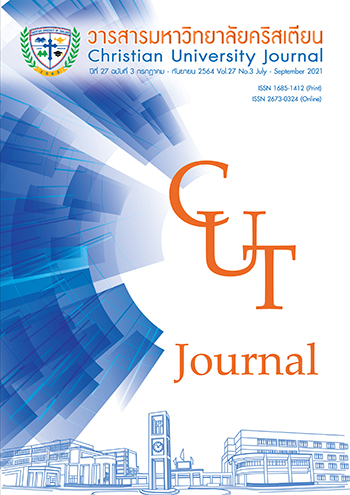การทดสอบเดิน 2 นาที และ 2 นาทีแรกของการทดสอบเดิน 6 นาที ในผู้ใหญ่ไทยสุขภาพดีอายุ 20 – 60 ปี
คำสำคัญ:
การทดสอบเดิน, ความสัมพันธ์, สมรรถภาพการเดินบทคัดย่อ
การทดสอบเดิน ถูกนำมาใช้ประเมินความสามารถในการทำงานของร่างกายเชิงปริมาณ การทดสอบเดิน 2 นาที (2MWT) ได้รับความนิยมเนื่องจากใช้ระยะเวลาสั้นและมีความสัมพันธ์กับการทดสอบเดิน 6 นาที (6MWT) การศึกษาวิเคราะห์เชิงตัดขวางนี้ มีวัตถุประสงค์เพื่อตรวจสอบ 1) ความน่าเชื่อถือของการทดสอบซ้ำของ 2MWT 2) ระยะทางเดินใน 2MWT และ 6MWT 3) ความสัมพันธ์ระหว่าง ผลลัพธ์ของ 2MWT และ 2 นาทีแรกของ 6MWT และ 4) ความสัมพันธ์ระหว่างผลลัพธ์โดยประมาณของ 6MWT โดยใช้ระยะทาง 2MWT ในสมการเชิงเส้นและผลลัพธ์ที่ทดสอบได้จริงของ 6MWT ผู้เข้าร่วมวิจัย 60 คน ได้รับการประเมินโดยใช้ 2MWT จำนวน 3 ครั้ง และ 6MWT จำนวน 1 ครั้งในลำดับแบบสุ่ม การทดสอบทั้งสองดำเนินการตามแนวปฏิบัติการทดสอบในทางเดินพื้นราบความยาว 21 เมตร ผลการศึกษาแสดงให้เห็นว่า ความน่าเชื่อถือของการทดสอบซ้ำของ 2MWT อยู่ในระดับดีมากโดยมีค่าสหสัมพันธ์ภายในชั้นระดับสูง (ICC=0.958, 95 CI; 0.936-0.974) ค่าเฉลี่ยระยะทาง 2MWT และระยะทาง 6MWT เท่ากับ 163.26±31.07 เมตรและ 468.90±99.28 เมตร ตามลำดับ พบค่าสัมประสิทธิ์สหพันธ์ในระดับสูงระหว่างผลลัพธ์ของ 2MWT จากการทดสอบครั้งแรก และ 2 นาทีแรกของ 6MWT (r=0.954; p<0.05) และระหว่างผลลัพธ์โดยประมาณของ 6MWT โดยใช้ระยะทาง 2MWT ในสมการเชิงเส้นและผลลัพธ์ที่ทดสอบได้จริงของ 6MWT (r=0.950; p<0.05) ดังนั้น การทดสอบเดินด้วย 2MWT เพียงหนึ่งครั้งสามารถใช้เป็นตัวแทนของผลการทดสอบ นอกจากนี้ ผลลัพธ์ของ 2MWT และการเดิน 2 นาทีแรกของ 6MWT สามารถนำไปใช้ในการประมาณผลลัพธ์ของ 6MWT ได้ 2MWT อาจเป็นการทดสอบการเดินทางเลือกที่สามารถนำมาประยุกต์ใช้ได้กับผู้ที่ไม่สามารถเดินได้เป็นเวลา 6 นาทีในการประเมินสมรรถภาพการเดิน
เอกสารอ้างอิง
American college of sports medicine. (2018). ACSM’s guidelines for exercise testing and prescription. (10th ed.). Philadelphia: Wolters Kluwer.
American Thoracic Society. (2002). ATS statement: guidelines for the six-minute walk test. American Journal of Respiratory and Critical Care Medicine, 166, 111–117.
Bohannon, R. W., King, N., & Gershon, R. (2015). Two-minute walk test (2MWT) performance by adults 18- 85 years: normative values, reliability and responsiveness. Archives of Physical Medicine & Rehabilitation, 96(3), 472-477.
Bohannon, R. W., Bubela, D., Magasi, S., McCreath, H., Wang, Y-C., Reuben, D., …Gershon, R. (2014). Comparison of walking performance over the first 2 minutes and the full 6 minutes of the Six-Minute Walk Test. BMC Research Notes, 7, 269. http://www.biomedcentral.com/1756-0500/7/269
Connelly, D. M., Thomas, B. K., Cliffe, S. J., Perry, W. M., & Smith, R. E. (2009). Clinical utility of the 2 - minute walk test for older adults living in long-term care. Physiotherapy Cannada, 61(2), 78-87.
Gijbels, D., Eijnde, B. O., & Feys, P.(2011). Comparison of the 2- and 6-min walk test in multiple sclerosis. Multiple Sclerosis, 17(10), 1269-1272.
Kim, A. L., Kwon, J. C., Park, I., Kim, J. N., Kim, J. M., Jeong, B. N., … Kim, Y. J. (2014). Reference equations for the six-minute walk distance in healthy Korean adults, aged 22-59 years. Tuberculosis and Respiratory Diseases (Seoul), 76(6), 269-275.
Kosak, M., & Smith, T. (2005). Comparison of the 2-, 6-, and 12-minute walk tests in patients with stroke. Journal of Rehabilitation Research and Development, 42(1), 103-108.
Leung, A.S., Chan, K. K., Sykes. K., & Chan, K. S. (2006). Reliability, validity, and responsiveness of a 2-min walk test to assess exercise capacity of COPD. Chest, 130(1), 119-125.
Selman, J. P. R., de Camargo, A. A., Santos, J., Lanza, F. C., & Corso, S. D. (2014). Reference equation for the 2-minute walk test in adult and the elderly. Respiratory Care, 59(4), 525-530.
Solway, S., Brooks, D., Lacasse, Y., & Thomas, S. (2001). A qualitative systematic overview of the measurement properties of functional walk tests used in the cardiorespiratory domain. Chest, 119, 256-270.
Zou, H., Zhu, X., Zhang, J., Wang, Y., Wu, X., Liu, F.,…Chen, X. (2017). Reference equations for the six-minute walk distance in the healthy Chinese population aged 18-59 years. PLoS One., 12 (9) :e0184669. doi: 10.1371/journal.pone.0184669. eCollection 2017.



